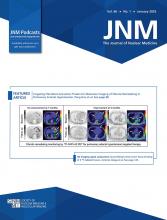Visual Abstract
Abstract
Poly(adenosine diphosphate–ribose) polymerase-1 (PARP1) inhibitors have improved ovarian cancer treatment outcomes. However, clinical response remains heterogeneous. Existing biomarkers, mainly breast cancer susceptibility genes 1 and 2 (BRCA1/2), are suboptimal. New tools are needed to guide patient selection. In this study, [18F]fluorthanatrace ([18F]FTT), a PET radiotracer for imaging PARP1, was compared with [18F]FDG and tumor features commonly assessed in ovarian cancer. Methods: Subjects with epithelial ovarian cancer underwent both [18F]FTT and [18F]FDG PET before new oncologic treatment. The SUVmax of [18F]FTT and [18F]FDG was compared between lesions. [18F]FTT SUVmax was compared with tumor location, tumor grade, and germline or somatic BRCA1/2 status. Linear mixed models were fitted to identify subject-level differences. Results: Fifty-five lesions were identified in 14 subjects. No correlation was found between [18F]FTT SUVmax and [18F]FDG SUVmax per lesion, supporting distinct molecular targets. [18F]FTT uptake varied widely across lesions, with no significant differences between mean SUVmax and tumor location, grade, or BRCA1/2 status. Conclusion: Our findings suggest that [18F]FTT PET may provide unique information on ovarian cancer distinct from [18F]FDG PET and commonly assessed tumor features. Our results imply a wide range of PARP1 expression in the studied ovarian tumors not explained by [18F]FDG PET, location, grade, or mutational status.
Footnotes
Published online Dec. 5, 2024.
- © 2025 by the Society of Nuclear Medicine and Molecular Imaging.
This article requires a subscription to view the full text. If you have a subscription you may use the login form below to view the article. Access to this article can also be purchased.
SNMMI members
Login to the site using your SNMMI member credentials
Individuals
Login as an individual user








